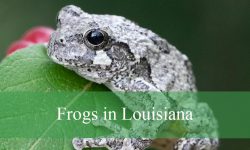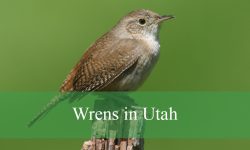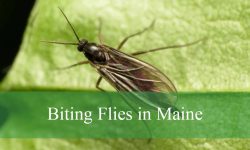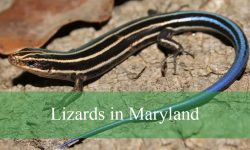Owls are fascinating creatures known for their nocturnal habits, silent flight, and haunting calls. With over 200 species worldwide, they vary greatly in size, appearance, and behavior. North America is particularly rich in owl diversity, home to some of the most iconic and well-loved species. From the majestic Great Horned Owl to the tiny Elf Owl, these birds are found in a variety of habitats, ranging from dense forests to open deserts.
In this article, we explore 20 popular types of owls, including their identifying features, habitats, and unique behaviors. Whether you’re a birdwatcher or simply curious about these enigmatic birds, this guide will help you recognize and appreciate the diversity of owls, especially those found in North America.
Different Types of Owls
Northern Hawk Owl
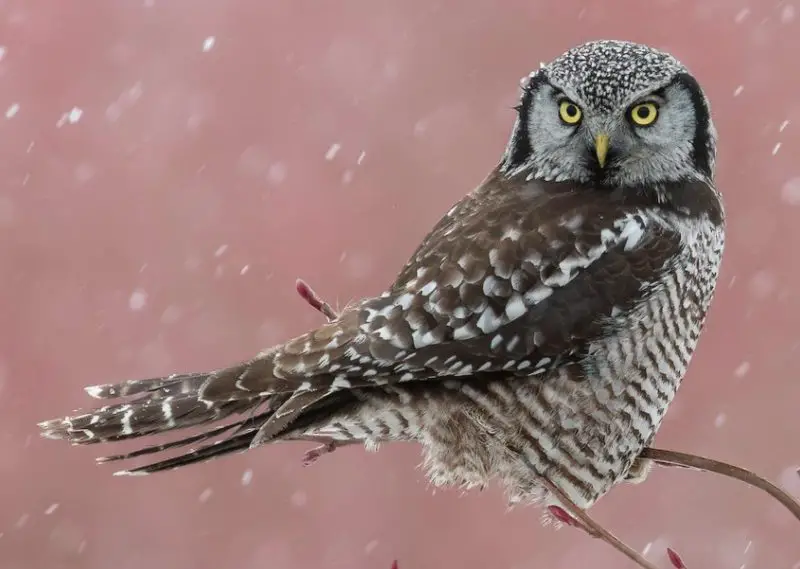
The Northern Hawk Owl is a medium-sized owl with a unique appearance and behavior that resembles a hawk. It measures about 36-45 cm in length with a wingspan of 69-82 cm. It has a smoky white face bordered in black, yellow eyes, and a long, tapered tail. Its brown and white barred plumage provides effective camouflage in its forested habitat. Unlike most owls, the Northern Hawk Owl is diurnal, hunting during the day with the agility and speed of a hawk.
This owl is found in boreal forests of North America and Eurasia, particularly in Alaska, Canada, Scandinavia, and Siberia. It prefers open forests, bogs, and areas with scattered trees, where it hunts small mammals and birds from high perches. The Northern Hawk Owl is known for its exceptional eyesight, which helps it spot prey from great distances. It nests in tree cavities or abandoned woodpecker holes and remains in its northern habitat year-round, even enduring harsh winter conditions.
Northern Pygmy-Owl
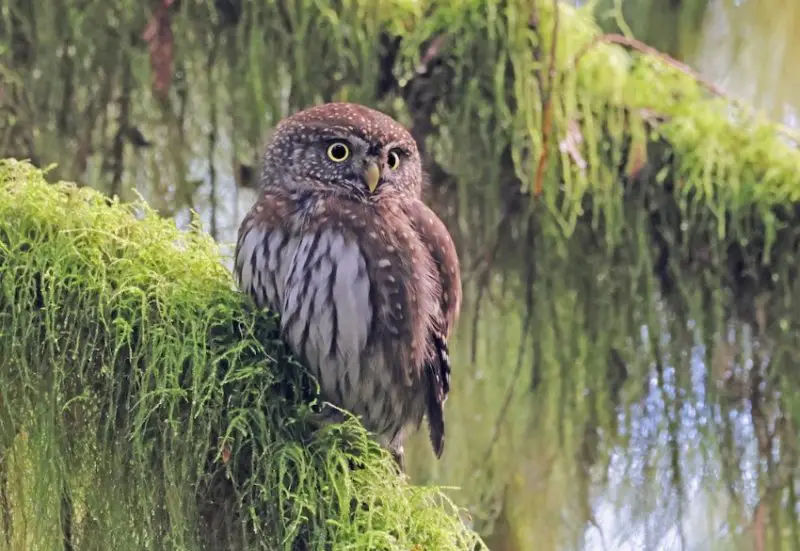
The Northern Pygmy-Owl is a small yet fierce predator known for its yellow eyes and distinctive “false eyes” on the back of its head. These dark spots create the illusion of eyes to confuse predators. Measuring about 16-18 cm in length with a wingspan of 38 cm, it has a rounded head with no ear tufts and brownish-gray plumage streaked with white. Despite its petite size, this owl is known for its bold behavior and fearless hunting style.
This owl is native to North America, primarily found in the western United States, Canada, and parts of Mexico. It prefers coniferous and mixed forests, particularly in mountainous regions. Unlike most owls, the Northern Pygmy-Owl is diurnal, hunting during the day for small mammals, birds, and insects. It nests in tree cavities made by woodpeckers and is often mobbed by songbirds that recognize its predatory nature. Its rapid, high-pitched tooting call is commonly heard echoing through forested valleys.
Barn Owl
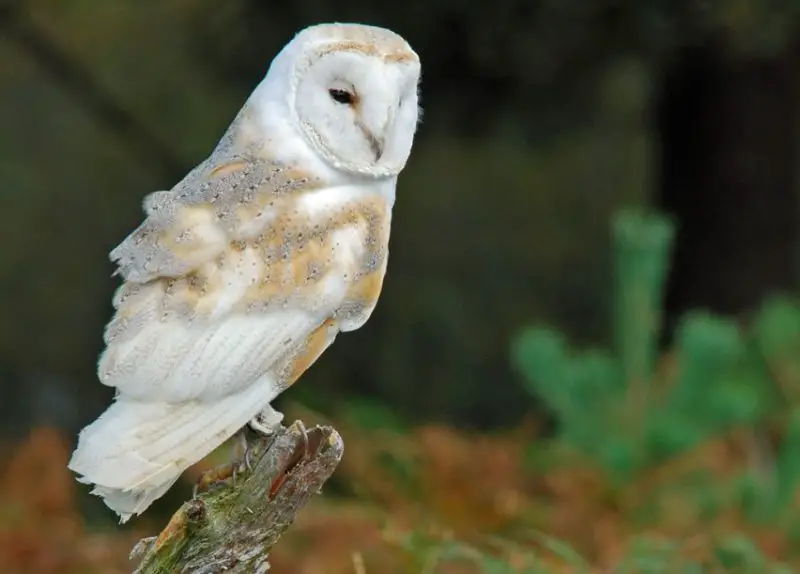
Barn owls are found on every continent except Antarctica, making them one of the most widespread owl species. They are commonly seen in North America, Europe, Africa, Asia, and Australia. In North America, they are typically found from southern Canada to the southern tip of South America. Their adaptability to various climates has allowed them to thrive in a wide range of environments.
These owls prefer open habitats such as farmlands, grasslands, marshes, and even suburban areas. They are often found in agricultural regions where they can easily hunt rodents. Barn owls also nest in old buildings, barns, and hollow trees, which provide safe shelter. Their presence is more frequent in rural landscapes, but they can also adapt to urban fringes as long as there is enough open space for hunting.
Barred Owl
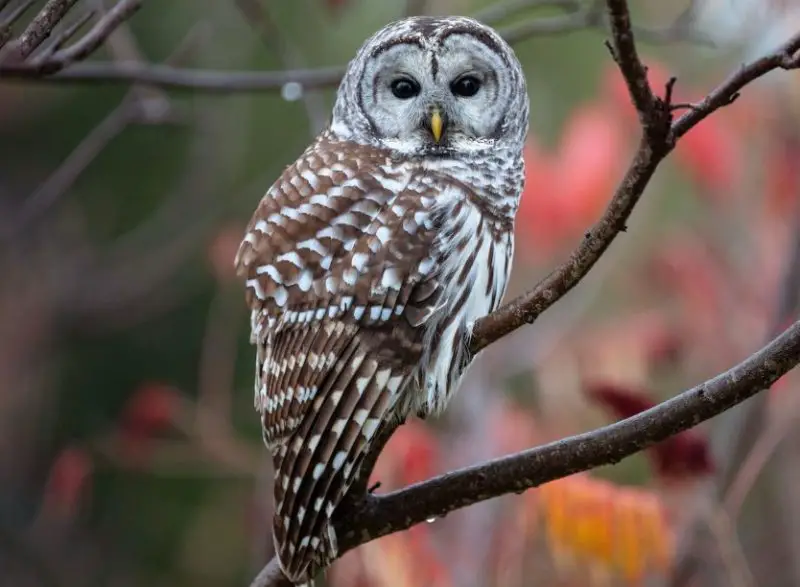
Barred owls are native to North America and are primarily found in the eastern United States, southeastern Canada, and parts of the Pacific Northwest. Over the past century, they have expanded their range westward into British Columbia, Washington, Oregon, and California. Their ability to adapt to new environments has contributed to their growing population in these areas.
These owls inhabit mature forests with dense foliage, particularly mixed woodlands of deciduous and coniferous trees. They are commonly found near rivers, swamps, and wooded ravines, where they can hunt for small mammals, birds, and amphibians. Barred owls are also known to reside in suburban areas with large trees, making them relatively easy to spot in city parks and neighborhoods with mature vegetation.
Boreal Owl
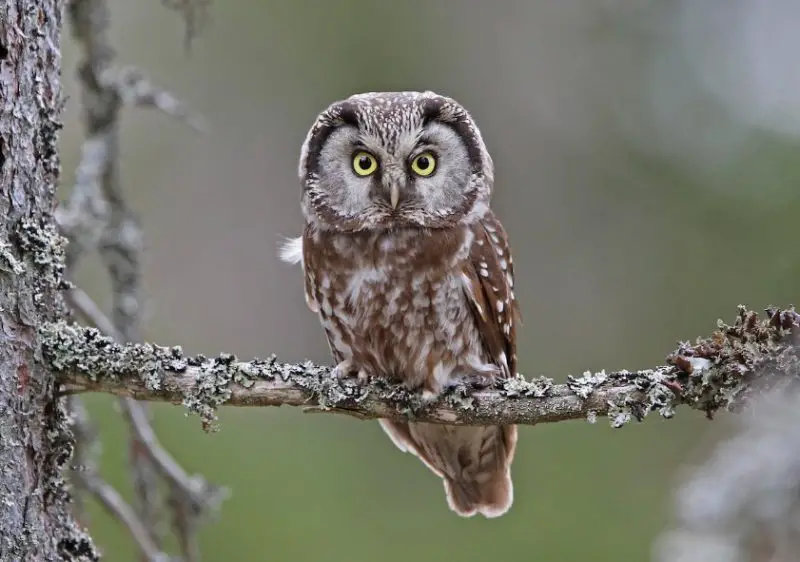
The boreal owl is primarily found in the northern regions of North America and Eurasia. In North America, they are commonly seen across Alaska, Canada, and the northern parts of the Rocky Mountains. In Europe and Asia, they inhabit boreal and subalpine forests from Scandinavia to Siberia. Their distribution is closely linked to cold, forested environments.
Boreal owls prefer dense coniferous forests, especially those dominated by spruce and fir trees. They thrive in mountainous regions and high-altitude woodlands, where they can hunt small mammals like voles and shrews. Due to their secretive nature and remote habitats, boreal owls are rarely seen by humans, but their distinct calls can be heard in the stillness of northern nights.
Burrowing Owl
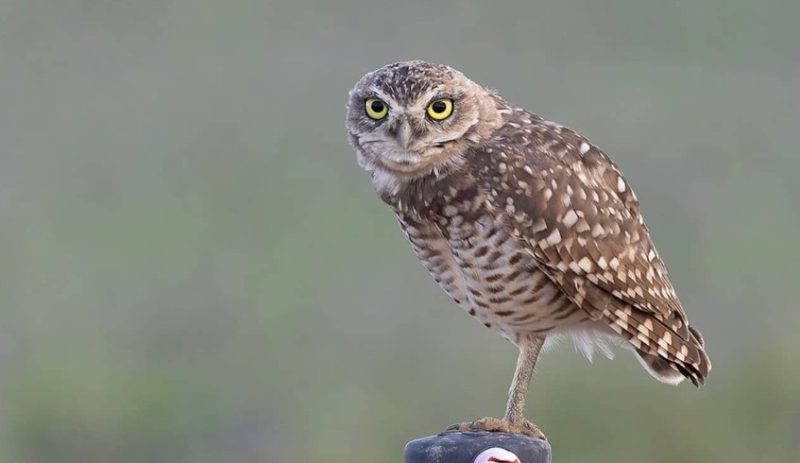
The burrowing owl is a small, ground-dwelling owl measuring 19-28 cm in length with a wingspan of 50-61 cm. It has a mottled brown body speckled with white, a rounded head, and striking yellow eyes without ear tufts. Its long legs help it move swiftly on the ground, making it unique among owls. Unlike most owls, the burrowing owl is diurnal, meaning it hunts during the day as well as at dawn and dusk.
These owls are commonly found in open landscapes such as grasslands, deserts, and agricultural fields across North and South America. In North America, they are frequently seen in the western United States, Florida, Mexico, and Central America. They nest in abandoned burrows made by animals like prairie dogs or ground squirrels, forming colonies for better protection. They are known for their unusual defense mechanism of mimicking rattlesnake sounds to deter predators.
Eastern Screech-Owl
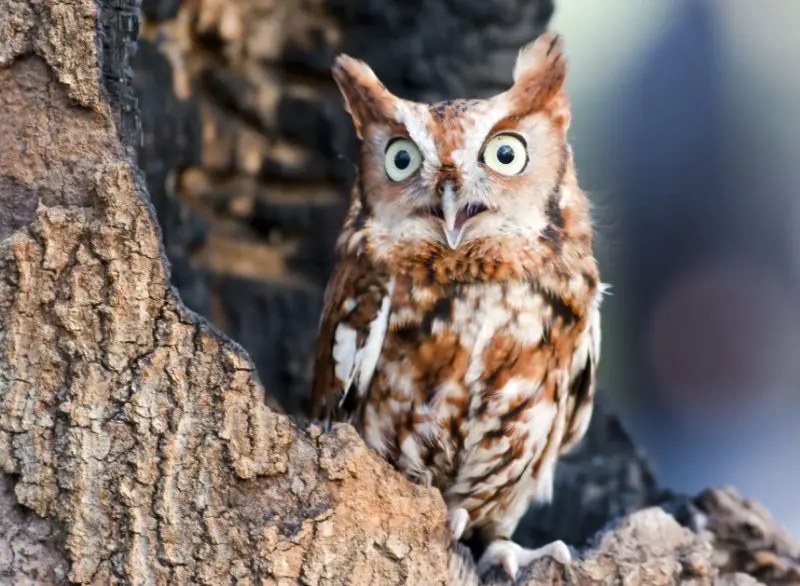
The Eastern Screech-Owl is a small, stocky owl measuring 16-24 cm in length with a wingspan of 48-61 cm. It has yellow eyes and small ear tufts that it can raise when alert or camouflage when resting. Its plumage varies between two color morphs: reddish-brown or gray, which helps it blend seamlessly into tree bark, making it difficult to spot during the day.
This owl is native to eastern North America, ranging from southern Canada through the eastern United States to northern Mexico. It inhabits diverse habitats, including deciduous forests, orchards, parks, and suburban areas. Eastern Screech-Owls are primarily nocturnal, hunting insects, small mammals, and birds. They are solitary outside of the breeding season but are vocal, producing a variety of sounds, including trills, screeches, and soft hoots, especially during the mating season.
Elf Owl
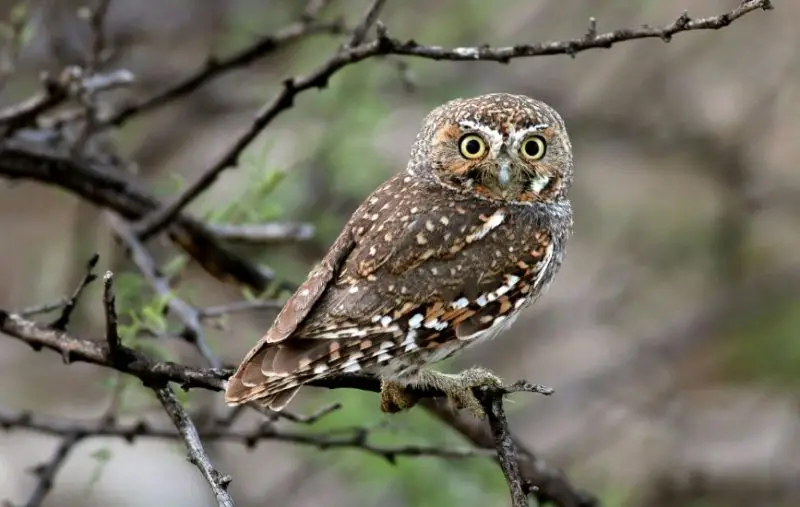
The Elf Owl is the world’s smallest and lightest owl species, measuring only 12.5-14.5 cm in length with a wingspan of about 27 cm. It has a short tail, reddish-brown plumage, and lacks ear tufts, giving it a rounded, delicate appearance. Despite its tiny size, the Elf Owl is known for its loud, high-pitched yapping calls, which echo through the night.
These owls are primarily found in desert habitats of the southwestern United States and Mexico, particularly in areas with giant saguaro cacti and thorn scrub forests. They nest in abandoned woodpecker holes in trees or cacti, which provide protection from predators. Being nocturnal, they hunt insects such as scorpions, beetles, and grasshoppers. Their small size and agile flight make them well-adapted to navigating dense vegetation in search of prey.
Ferruginous Pygmy-Owl
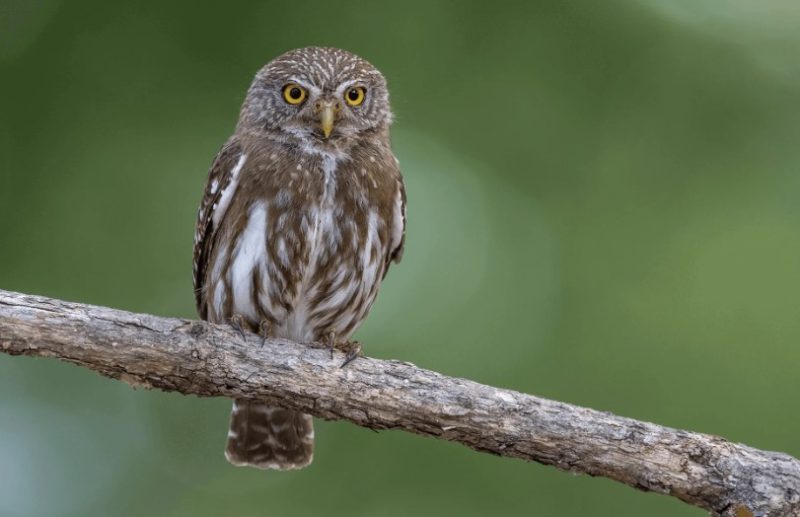
The Ferruginous Pygmy-Owl is a small, stocky owl with cinnamon or gray plumage, accented by distinctive black bars on its reddish tail. It has a rounded head without ear tufts and piercing yellow eyes, giving it a fierce and alert expression. Despite its petite size, this owl is known for its bold and aggressive behavior, even attacking larger birds to defend its territory.
These owls are primarily found in the southwestern United States, Mexico, Central America, and parts of South America. They prefer semi-open habitats such as thorn forests, woodlands, and desert edges. Ferruginous Pygmy-Owls are diurnal hunters, active during the day and at dusk, preying on insects, small mammals, and birds. They often nest in tree cavities or cacti, forming strong pair bonds with their mates and fiercely protecting their nesting sites from intruders.
Flammulated Owl
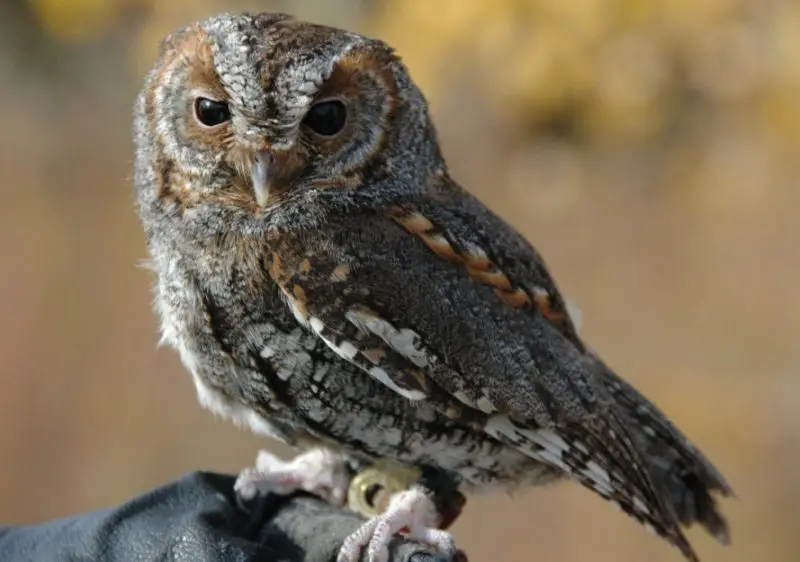
The Flammulated Owl is a small, nocturnal species known for its dark eyes and small ear tufts. Measuring 15-18 cm in length with a wingspan of 36-42 cm, this owl is well-camouflaged in its natural habitat. It comes in two color morphs: rusty-red and gray, which blend seamlessly with tree bark. Its soft, hooting call is often the only indication of its presence in the wild.
Flammulated Owls inhabit mountainous forests in western North America, especially in areas dominated by pine and fir trees. They are migratory birds, breeding in the United States and Canada before wintering in Central America. These owls primarily hunt insects such as moths and beetles, using a sit-and-wait strategy from perches. They nest in abandoned woodpecker holes, making them highly dependent on healthy, mature forests for survival.
Great Gray Owl
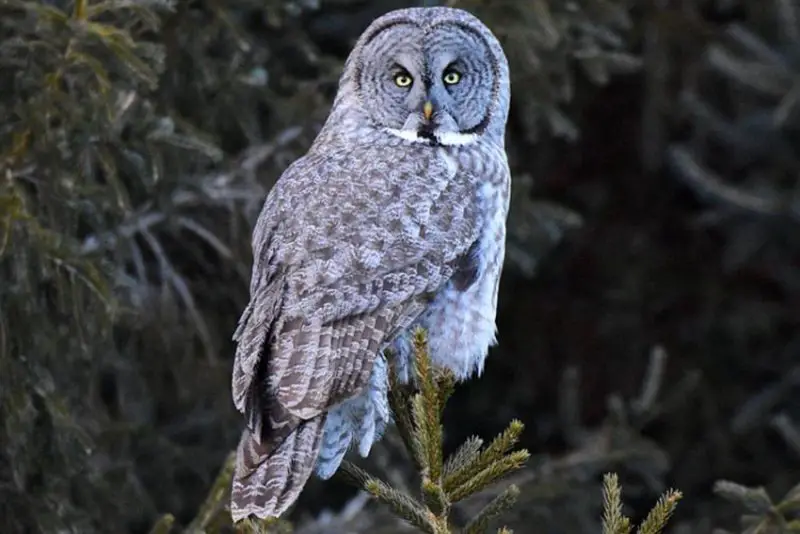
The Great Gray Owl is the largest owl species by length, measuring 61-84 cm with an impressive wingspan of 137-153 cm. It has a distinctive round face with a large facial disc, yellow eyes, and no ear tufts. Its dense, grayish plumage is streaked with white, helping it blend into the snowy and wooded environments it inhabits. Despite its massive size, this owl is surprisingly lightweight due to its fluffy feathers.
These owls are primarily found in dense boreal forests of North America, including Alaska, Canada, and the northern United States, as well as parts of northern Europe and Asia. They are nocturnal hunters, relying on their exceptional hearing to locate small mammals beneath the snow. Great Gray Owls typically nest in abandoned raptor nests or tree cavities. They are known for their silent flight and haunting calls, which echo through the cold, dense forests they call home.
Great Horned Owl
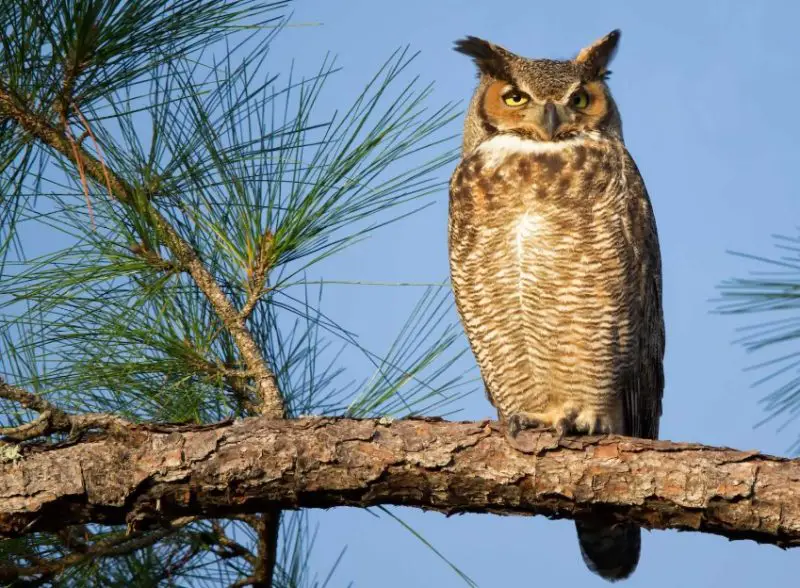
The Great Horned Owl is a large and powerful owl, known for its distinctive ear tufts and piercing yellow eyes. Measuring 43-64 cm in length with a wingspan of 91-153 cm, it has a broad chest and a thick, muscular build. Its plumage is a mix of gray, brown, and white, providing excellent camouflage in its wooded habitats. This owl’s deep, resonant hooting call is iconic and often heard echoing through the night.
Great Horned Owls are highly adaptable and can be found throughout North and South America, from the Arctic treeline to the southern tip of South America. They inhabit a wide range of environments, including forests, deserts, wetlands, and even urban areas. Their varied diet includes small mammals, birds, reptiles, and even other owls, showcasing their remarkable hunting skills. These owls are also known to nest in abandoned nests of other large birds, making them a dominant predator wherever they reside.
Long-Eared Owl
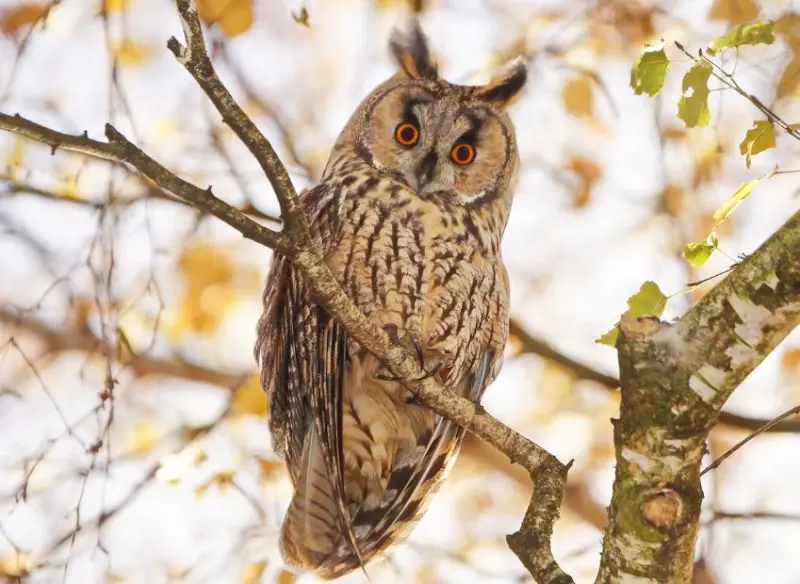
The Long-Eared Owl is a medium-sized owl distinguished by its exceptionally long ear tufts and orange facial disc. Its slender body measures about 31-40 cm in length with a wingspan of 86-100 cm. It has yellow eyes and brownish plumage with intricate streaks and barring, allowing it to blend into tree branches. This owl’s ear tufts are not for hearing but are used for camouflage and communication.
These owls are found across North America, Europe, and Asia, favoring semi-open habitats like woodland edges, shrublands, and grasslands. They are primarily nocturnal hunters, using their excellent hearing to locate small mammals like voles and mice in the darkness. During the winter, Long-Eared Owls often roost communally in dense foliage or coniferous trees, sometimes forming groups of up to 20 individuals. They nest in abandoned stick nests made by other birds, such as crows or hawks.
Whiskered Screech-Owl
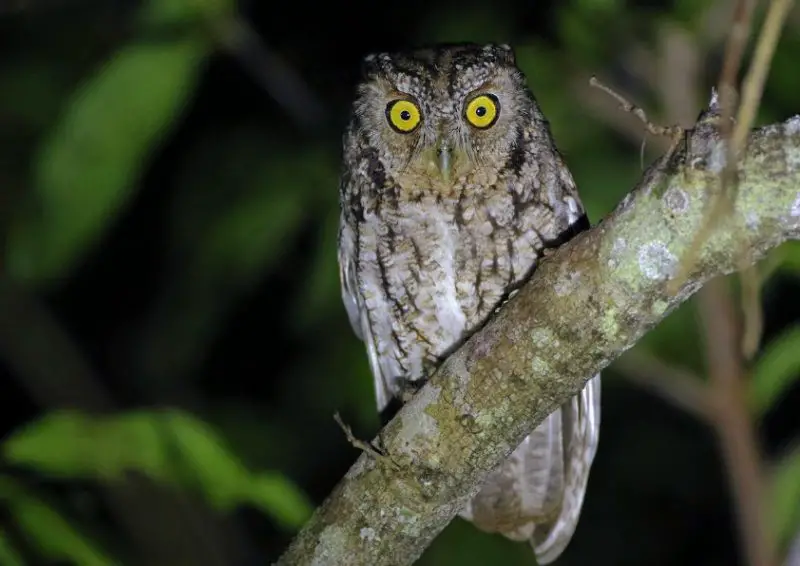
The Whiskered Screech-Owl is a small, nocturnal owl known for its grayish-brown plumage, golden eyes, and small ear tufts. It measures about 16-20 cm in length with a wingspan of approximately 45 cm. Its feathers are streaked and mottled, providing excellent camouflage against tree bark. The owl’s name comes from the fine, whisker-like feathers around its facial disc. Its distinctive call is a series of spaced notes, resembling Morse code, which can be heard echoing through dense forests at night.
This owl is found in the mountainous regions of Mexico and the southwestern United States, particularly in Arizona and New Mexico. It prefers dense, mature forests, including oak and pine woodlands, where it nests in tree cavities or abandoned woodpecker holes. The Whiskered Screech-Owl is an insectivore, feeding mainly on moths, beetles, and other small invertebrates. In some areas, it faces threats from habitat loss and competition with other owl species. Conservation efforts are underway to protect its natural habitats and ensure the survival of this unique and beautifully camouflaged species.
Northern Saw-Whet Owl
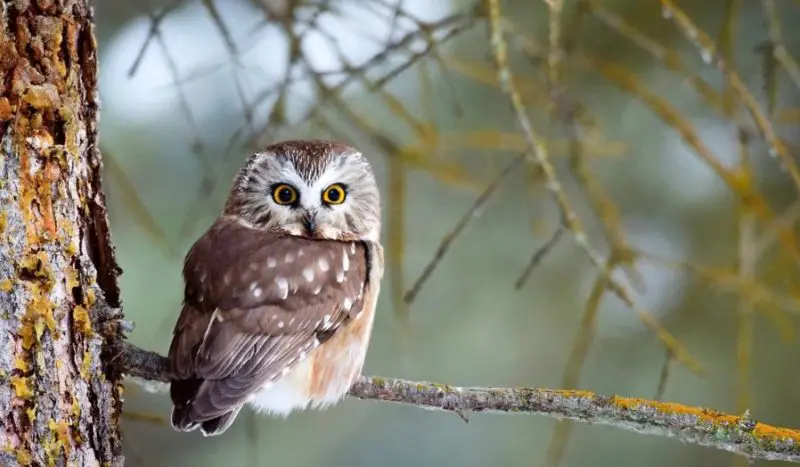
The Northern Saw-Whet Owl is a small, nocturnal owl, measuring 17-21 cm in length with a wingspan of 42-56 cm. It has a round head with no ear tufts, bright yellow eyes, and a distinctive white Y-shaped marking on its facial disc. Its brown plumage is streaked with white, providing excellent camouflage among tree branches. This owl’s endearing appearance and small size make it a favorite among birdwatchers.
These owls are found throughout North America, from southern Canada to central Mexico. They prefer dense coniferous forests, including spruce, fir, and cedar woods. Northern Saw-Whet Owls nest in old woodpecker holes or natural tree cavities. They are primarily nocturnal hunters, feeding on small mammals like mice and shrews. Their name comes from their unique, high-pitched “toot” call, which resembles the sound of a saw being sharpened. This distinctive call can be heard during the breeding season, echoing through the quiet forest night.
Short-Eared Owl
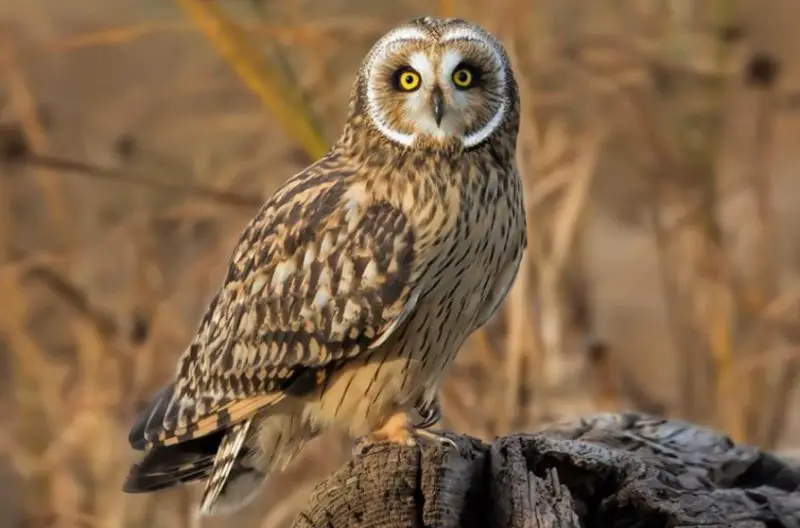
The Short-Eared Owl is a medium-sized owl known for its round head, large yellow eyes, and short, barely visible ear tufts. It measures about 34-43 cm in length with a wingspan of 85-110 cm. Its plumage is mottled tawny to brown with streaks, which helps it blend into its grassland and marsh habitats. It is recognized by its erratic, moth-like flight pattern, often observed while hunting low over open fields.
This species is found on every continent except Antarctica, making it one of the most widespread owl species. In North America, they inhabit open landscapes such as grasslands, marshes, prairies, and agricultural fields. Unlike most owls, the Short-Eared Owl is crepuscular, being active during the day at dawn and dusk, as well as at night. They primarily feed on small mammals, especially voles. These owls nest on the ground in shallow scrapes lined with grass and feathers. In winter, they may form loose communal roosts, gathering in groups to rest and conserve warmth.
Snowy Owl
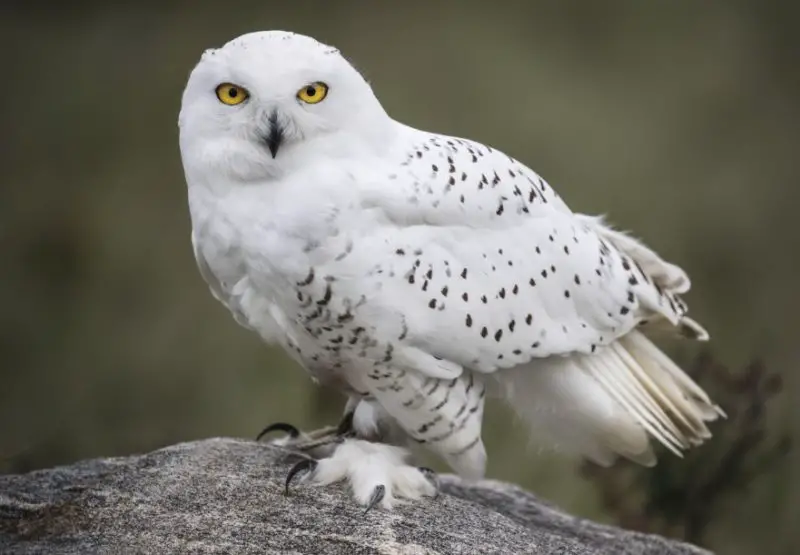
The Snowy Owl is one of the most beautiful and easily recognizable owl species, known for its striking white plumage. Adult males are almost pure white, while females and juveniles have black markings scattered across their feathers. It is a large owl, measuring 52-71 cm in length with a wingspan of 125-150 cm. Its rounded head, yellow eyes, and feathered feet make it well-adapted to its cold, open habitats.
Snowy Owls are native to the Arctic tundra of North America, Europe, and Asia, but they often migrate south in the winter, reaching Canada, the northern United States, and even parts of Europe. They prefer open areas such as tundras, coastal dunes, and grasslands, where they hunt during the day, especially in the continuous daylight of Arctic summers. Their primary prey is lemmings, but they also hunt small mammals and birds. Snowy Owls are known for their nomadic behavior, moving great distances depending on food availability.
Spotted Owl
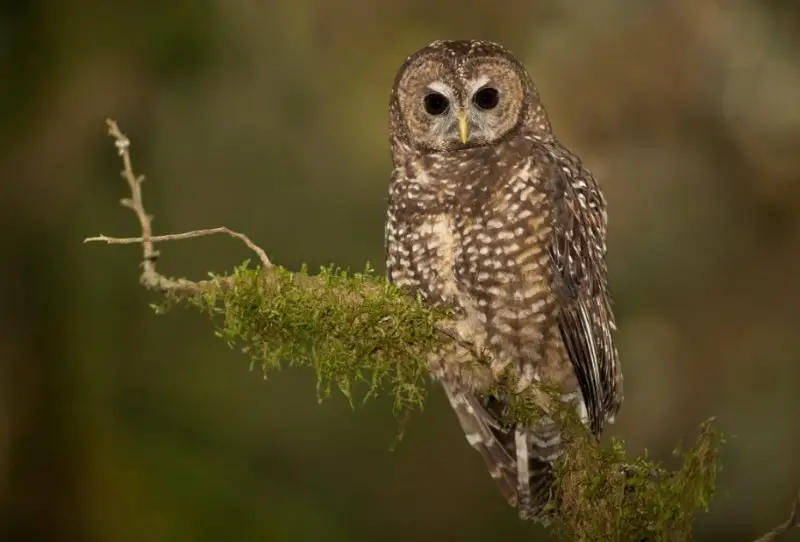
The Spotted Owl is a medium-sized owl recognized by its dark brown plumage adorned with white spots. It has a round head, dark brown eyes, and no ear tufts, giving it a gentle and inquisitive expression. Measuring about 43-48 cm in length with a wingspan of 114 cm, it is a relatively large, stocky owl that moves gracefully through dense forest canopies.
These owls are native to North America, specifically in the old-growth forests of the western United States and Mexico. They inhabit mature coniferous forests with dense canopy cover, where they nest in cavities of tall trees, broken-topped snags, or abandoned raptor nests. The Spotted Owl is primarily nocturnal, hunting small mammals such as flying squirrels and woodrats. Unfortunately, their population is declining due to habitat loss from logging and increased competition with the more aggressive Barred Owl. Conservation efforts are ongoing to protect their critical habitats.
Western Screech-Owl
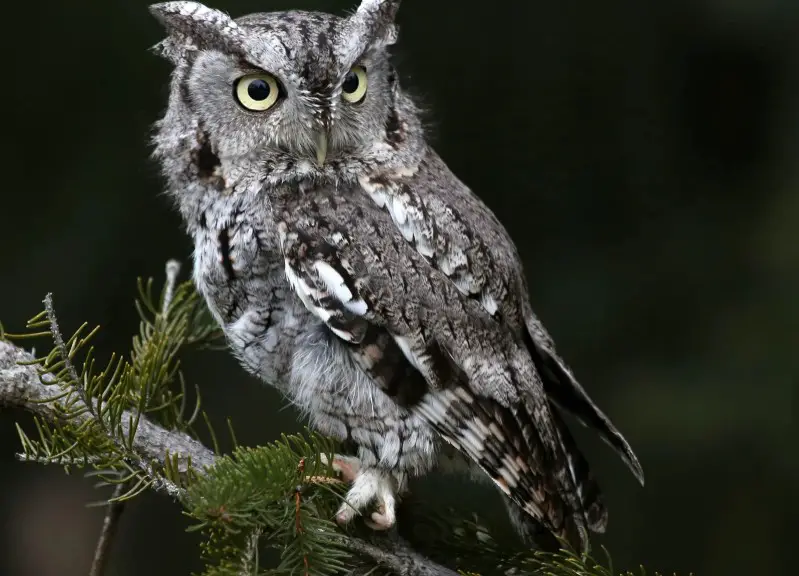
The Western Screech-Owl is a small, nocturnal owl native to North and Central America. It measures 19-25.5 cm in length with a wingspan of about 55 cm. This owl is characterized by its prominent feathered ear tufts, yellow eyes, and a pale facial disc bordered by dark markings. Its plumage varies from gray to brown, providing effective camouflage among tree bark and branches.
Western Screech-Owls prefer a variety of forested habitats, including deciduous, coniferous, and mixed woodlands, as well as urban parks and suburban areas. They nest in natural tree cavities or old woodpecker holes, making them dependent on healthy forest ecosystems. These owls are known for their distinctive calls, which include a series of rapid hoots and trills. As opportunistic hunters, they feed on small mammals, birds, insects, and even fish. They play an important ecological role as both predator and prey, contributing to the balance of their forest habitats.

